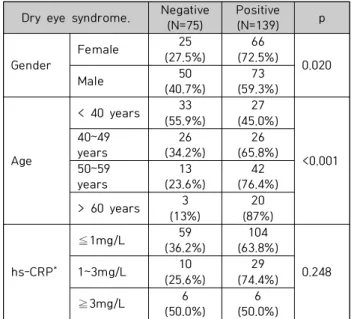JKSCI
What is the meaning of hs-CRP and HbA1c in patients with dry eye syndrome in diabetes?
1)
Ji-Hun Kang*, Sang-Yol Shin**
*Professor, Dept. of Emergency Medicine at Inje University Busan Paik Hospital, Busan, Korea
**Professor, Dept. of Emergency Medical Service, Howon University, Gunsan, Korea
[Abstract]
The purpose of this study was to investigate the effects of systemic chronic inflammatory state on dry eye syndrome as a local chronic inflammatory condition. From June 16, 2016 to December 31, 2016, 726 patients who visited the general health examination center were screened using the Schirmer’s test and the metabolic syndrome screening test. A total of 214 patients who were studied for hs-CRP and HbA1c were simultaneously selected for the study as well. Dry eye syndrome significantly increased in higher age groups (p<0.001) and women (p=0.020); there was no significant relationship with fasting plasma glucose, hs-CRP.
In addition, as HbA1c increased the risk for dry eye syndrome also increased (β=1.960, p=0.025). Therefore, dry eye syndrome may not caused by microvascular changes in the lacrimal gland due to chronic inflammatory conditions. In diabetic patients, long-term blood glucose control may be more important than short-term blood glucose control. The high prevalence of dry eye syndrome in diabetic patients is thought to be due to autonomic dysfunction rather than microvascular changes caused by chronic inflammation.
▸Key words: Dry eye syndrome, Blood glucose, HbA1c, hs-CRP
[요 약]
본 연구는 2016년 6월 16일부터 2016년 12월 31일까지 건강검진센터를 방문한 726명을 대상으로 Schirmer’s 검사와 대사증후군 검사를 통해 전신적 만성 염증성 상태가 국소적 만성 염증성 상태로서의 안구건조증에 미치는 영향을 알아보고자 시행하였다. 대상자중 hs-CRP, HbA1c를 동시 측정한 214명을 대상으로 연구를 진행하였다 . 연구대상자 중 고 연령일수록 (p<0.001), 성별로는 여성에서 유의하게 안구건조증이 증가하였으며(p=0.020), 공복혈당과 hs-CRP와는 연관이 없었다. 또한 HbA1c가 증가할수 록 안구건조증에 대한 위험도가 증가하였다(β=1.960, p=0.025). 따라서 안구건조증은 만성 염증성 상태 로 인한 눈물샘의 미세혈관 변화에 의한 것이 아니며 당뇨환자의 경우 단기간의 혈당 조절보다 장기간의 혈당 조절상태가 더욱 중요하게 작용할 수 있음을 알 수 있으며 당뇨병 환자에서 안구 건조증의 높은 유병률은 만성 염증으로 인한 미세 혈관 변화보다는 자율 기능 장애로 인한 것으로 생각된다.
▸주제어: 안구건조증, 혈당, HbA1c, hs-CRP
∙First Author: Ji-Hun Kang, Corresponding Author: Sang-Yol Shin
*Ji-Hun Kang (emmdkjh@naver.com), Dept. of Emergency Medicine at Inje University Busan Paik Hospital **Sang-Yol Shin (since2000@howon.ac.kr), Dept. of Emergency Medical Service, Howon University
∙Received: 2019. 08. 08, Revised: 2020. 03. 13, Accepted: 2020. 03. 15.
Copyright ⓒ 2020 The Korea Society of Computer and Information http://www.ksci.re.kr pISSN:1598-849X | eISSN:2383-9945

